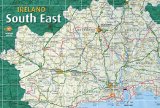South East Ireland Tourism
Travel guide to Ireland's south east
Travel guide to Ireland's south east
Portlaw, Waterford
Built by the Malcolmsons as a model village for the workers of their cotton-spinning mills, Portlaw suffered when the Irish industry was squeezed by protective tax barriers. These were forced on the parliament at Westminster by English interests to protect their trade during the 19th century.
It later became a centre for the tannery industry in Ireland. The parish church dates from 1858 and was designed by J.J. McCarthy, known as ‘the Irish Pugin’. North of the village, but not open to the public, is Mayfield, an 1840s Italianate house, built for the Malcolmsons.
The entrance Hall and Tower were built shortly after the family arrived in 1170. St. Hubert’s Stag, the massive crest of the Le Poers, dominates the three tier tower. The semi-Georgian block was added in the 18th century at which time Catherine Poer, Countess of Tyrone, personally decorated the Shell Grotto. She married Sir Marcus Beresford and their eldest son was created the First Marquis of Waterford. Plasterwork in the interior is attributed to the famous Francini brothers
A primeval forest and a stretch of the River Clodiagh are incorporated in the woods of the demesne. Over the river is a many arched medieval bridge, reputedly used by King John in 1205.
Follow the Waterford/Suir Valley Drive from Portlaw. Kilbunny Church, signposted right, was dedicated to St. Munnu, and is now a ruin containing fragments of a Power Tomb and a 17th century figure. Continue on the R680 until the road branches. Keep left on the minor road which runs close to the river. Take this road to the well known Mount Congreve Gardens, left.
*As indicated above, Portlaw is one of the villages which features on the very scenic Suir Valley Drive.
<< Return to Waterford page
It later became a centre for the tannery industry in Ireland. The parish church dates from 1858 and was designed by J.J. McCarthy, known as ‘the Irish Pugin’. North of the village, but not open to the public, is Mayfield, an 1840s Italianate house, built for the Malcolmsons.
What to see and do around Portlaw
To the west of the village is the Curraghmore Estate, home of the Marquis of Waterford and his ancestors since the 12th century.The entrance Hall and Tower were built shortly after the family arrived in 1170. St. Hubert’s Stag, the massive crest of the Le Poers, dominates the three tier tower. The semi-Georgian block was added in the 18th century at which time Catherine Poer, Countess of Tyrone, personally decorated the Shell Grotto. She married Sir Marcus Beresford and their eldest son was created the First Marquis of Waterford. Plasterwork in the interior is attributed to the famous Francini brothers
A primeval forest and a stretch of the River Clodiagh are incorporated in the woods of the demesne. Over the river is a many arched medieval bridge, reputedly used by King John in 1205.
Follow the Waterford/Suir Valley Drive from Portlaw. Kilbunny Church, signposted right, was dedicated to St. Munnu, and is now a ruin containing fragments of a Power Tomb and a 17th century figure. Continue on the R680 until the road branches. Keep left on the minor road which runs close to the river. Take this road to the well known Mount Congreve Gardens, left.
*As indicated above, Portlaw is one of the villages which features on the very scenic Suir Valley Drive.
Portlaw Map
<< Return to Waterford page






